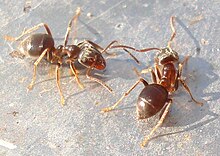Lasius
From Mei, (1998) [1]
The formicine ant genus Lasius Fabricius, 1804 is among the most prominent elements of the Holoarctic myrmecofauna, both for the high number of species and for the abundance and the ecological importance of several of these. The six species in the subgenus Cautolasius Wilson, 1955, with workers characterized by reduced eyes, shortened maxillary palps, large metapleural gland openings anddepigmented yellow—coloured integument, have hypogaeic life habits (Wilson, 1955). Until now only two species belonging to this subgenus, Lasiusjlavus (Fabricius, 1781) and Lasius myops Forel, 1894, were known to occur in Europe and all around the Mediterranean Basin (Seifert, 1983; Agosti & Collingwood, 1987; Suner et al., 1991).
From Wilson, (1955) [2]
Lasius is one of the most prominent and familiar of the Holarctic ant genera. From the time of Réaumur in the eighteenth century (VVheeler, 1926), European and North American entomologists have focused attention on it in countless general biological and taxonomic investigations which are today part of the classical foundation of myrmecology. g It is probably best " known for its conspicuous nuptial flights, its habit of tending and transporting homopterous insects, and the temporary parasitio behavior of some of its species. It has also attracted much attention as one of the several ant genera which have persisted in Europe and North America since early Tertiary times with only a small amount of visible evolutionary change. Today it occupies a purely Holarctic range. Northward it reaches northern Scandinavia, the Baikal region of Siberia, Kamchatka, southeastern Alaska, and southern Labrador. South- ward it reaches Madeira, North Africa, northern Iraq, the southern Himalayas, the mountains of Formosa, the mountains of central Mexico, and northern Florida. Where it comes closest geographically to tropical faunis, as in southeastern Asia, it still retains its north-temperate character, i.e., limited to temperate vegetation at higher elevations and there associated chiefly with typically Holarctic ant genera. Within this range it is among the most abundant of all insect genera., In Europe the two species niger and fiavus are often the overriding dominants of the ant fauna in local situations and under a variety of ecological conditions. In the eastern United States L. neoniger (=L. niger amerficanus div. auct.) mounts such dense populations in open fields and lawns that W. M. Wheeler was once moved (1905) to suggest that it might be the most abundant insect in North America. Such a contention would probably be an exaggeration with respect to all insects, of course, yet there is no denying mzoniger its importance as a major faunal influent within its range and favored habitat. Despite the great prominence of this genus, the taxonomy of Lasius, like that of most ant genera, has been a sorry shambles. In particular, there have been no keys that work satisfactorily; those in the literature today will not suffice to determine even the type specimens of many species. A principal reason for this condition is that some of the best diagnostic characters in the genus involve structures hitherto ignored. Furthermore, the nomenclature has been badly complicated by an excessive accumulation of poorly defined forms, mostly of a trivial infra speciiic nature. Out of the 110 unchallenged names which existed in the literature at the outset of this revision, I have been able to establish only 27 as representing valid species (not counting the six additional new species). The others patently serve only to obscure the true picture of intraspecitic variation and to render clearcut species diagnoses impossible. Finally, the situation has been aggravated by the hitherto unsuspected presence of a number of cryptic species closely related to some of the most common members of the genus. Formerly lumped with their named siblings, they have had the effect of broadening and confusing species diagnoses. Creighton (1950), for instance, recognizes only two forms of the subgenus
Lasius in North America, “niger ne0niger" and "aZienus americam¢s", which he and others have separated principally by a single character in pilosity. Actually, these two names apply to six distinct species in North America: sitkaensis Pergande, niger (Linnaeus), ctlienus (Foerster), neoniger Emery, crypiicus Wilson, and sitiens Wilson, each abundant and widely distributed. It is impossible to make a two—way split in this group on the basis of the pilosity character, since in this respect sitkaensis by itself brackets all of the variation shown by the other species. The taxonomy of the group was finally solved in the course of the present study by reference to other characters in dentition, clypeal outline, etc., combined with trends in pilosity. Beyond the urgent need for a purely taxonomic revision, Lasius has presented many excellent opportunities for studies of more general nature. Chief among its advantages in this respect is the large amount of available material, which has allowed extensive statistical descriptions and analyses. I have been able in the course of only two years to gather and examine an estimated total of 5,425 nest series containing approxi- mately 80,000 specimens. Not every specimen in every nest series was studied microscopically, but all were at least cursorily checked, and contributed to overall impressions of variability in size, color, and habitus. Lasius is also remarkable perhaps unique among animal groups thus far monographed, in its great abundance, ubiquity, and conspicuousness, and the consequent ease with which it can be found in the field. Anywhere in the northern United States, in practically all but desert and semidesert conditions, it is possible for an investigator to walk onto nearly any plot of ground and within a matter of minutes End nests of one or more species. As a result, surveys of population density and comparative ecology can be conducted swiftly and easily.
References
- , “Lasius (Cautolasius) myrmidon n. sp.: a new hypogaeic ant from Greece (Hymenoptera Formicidae). ”, Bollettino della Società Entomologica Italiana, vol. 130, pp. 177-182, 1998.
- , “A monographic revision of the ant genus Lasius.”, in Bulletin of the Museum of Comparative Zoology , vol. 113, 1955, pp. 1-201.
From Collingwood (1979) [1]
The antennae are 12 segmented in the worker and female, 13 segmented in the male. The antenna! insertions are situated at the posterior margin of the clypeus and segments 2 to 5 are not longer than the succeeding segments. Maxillary palps are 6 segmented, labial palps 4 segmented. The head of the worker caste is somewhat cordate with a posterior emargination in some species. The clypeus is broad and roun¬ded anteriorly. The frontal carinae are short and sub-parallel and in most species the frontal triangle is indistinctly defined. The orifice of the propodeal spiracle is circular or broadly oval situated close to the posterior propodeal border. Ocelli are minute or indistinct in the worker but distinct in the female and male. The petiole is vertical and scale-like in most species.
This genus contains about 42 species with a hoi arctic distribution. It was extensively revised by Wilson (1955). Members of this genus are predominantly aphidicolous but also carnivorous and scavenging. There are 14 species in Europe of which 10 are known to occur in Fennoscandia.
References
- , The Formicidae (Hymenoptera) of Fennoscandia and Denmark, vol. 8. Klampenborg, Denmark: Scandinavian Science Press Ltd., 1979, p. 156.
From Collingwood (1979) [1]
This genus contains about 42 species with a hoi arctic distribution. It was extensively revised by Wilson (1955). Members of this genus are predominantly aphidicolous but also carnivorous and scavenging. There are 14 species in Europe of which 10 are known to occur in Fennoscandia.
References
- , The Formicidae (Hymenoptera) of Fennoscandia and Denmark, vol. 8. Klampenborg, Denmark: Scandinavian Science Press Ltd., 1979, p. 156.



